Solar eclipse of October 25, 2041
An annular solar eclipse will occur on October 25, 2041. A solar eclipse occurs when the Moon passes between Earth and the Sun, thereby totally or partly obscuring the image of the Sun for a viewer on Earth. An annular solar eclipse occurs when the Moon's apparent diameter is smaller than the Sun's, blocking most of the Sun's light and causing the Sun to look like an annulus (ring). An annular eclipse appears as a partial eclipse over a region of the Earth thousands of kilometres wide.
| Solar eclipse of October 25, 2041 | |
|---|---|
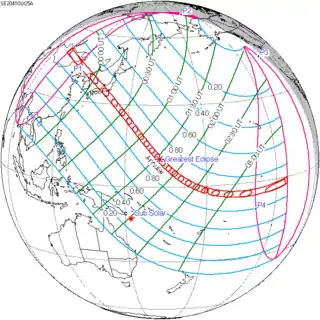 Map | |
| Type of eclipse | |
| Nature | Annular |
| Gamma | 0.4133 |
| Magnitude | 0.9467 |
| Maximum eclipse | |
| Duration | 367 sec (6 m 7 s) |
| Coordinates | 9.9°N 162.9°E |
| Max. width of band | 213 km (132 mi) |
| Times (UTC) | |
| Greatest eclipse | 1:36:22 |
| References | |
| Saros | 134 (45 of 71) |
| Catalog # (SE5000) | 9600 |
Images

Animated path
Related eclipses
Solar eclipses of 2040–2043
This eclipse is a member of a semester series. An eclipse in a semester series of solar eclipses repeats approximately every 177 days and 4 hours (a semester) at alternating nodes of the Moon's orbit.[1]
| Solar eclipse series sets from 2040–2043 | ||||
|---|---|---|---|---|
| Ascending node | Descending node | |||
| 119 | May 11, 2040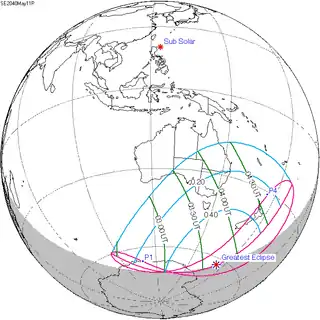 Partial |
124 | November 4, 2040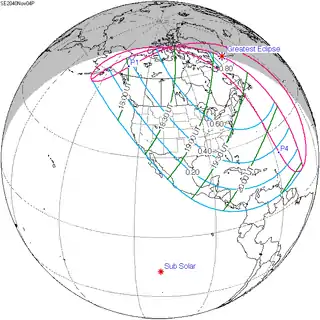 Annular | |
| 129 | April 30, 2041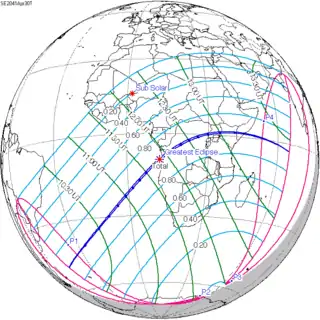 Total |
134 | October 25, 2041 Annular | |
| 139 | April 20, 2042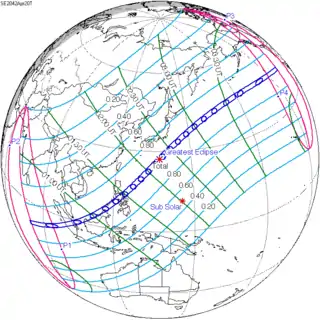 Total |
144 | October 14, 2042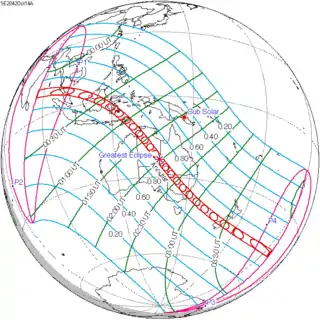 Annular | |
| 149 | April 9, 2043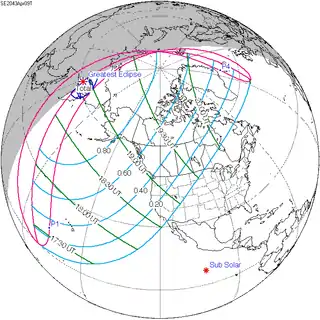 Total (non-central) |
154 | October 3, 2043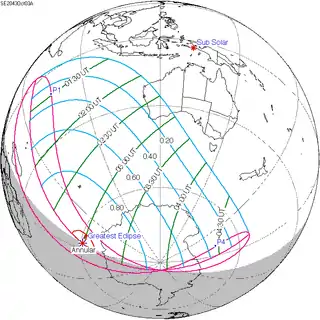 Annular (non-central) | |
Saros 134
It is a part of Saros cycle 134, repeating every 18 years, 11 days, containing 71 events. The series started with partial solar eclipse on June 22, 1248. It contains total eclipses from October 9, 1428 through December 24, 1554 and hybrid eclipses from January 3, 1573 through June 27, 1843, and annular eclipses from July 8, 1861 through May 21, 2384. The series ends at member 71 as a partial eclipse on August 6, 2510. The longest duration of totality was 1 minutes, 30 seconds on October 9, 1428. All eclipses in this series occurs at the Moon’s descending node.[2]
| Series members 32–48 occur between 1801 and 2100: | ||
|---|---|---|
| 32 | 33 | 34 |
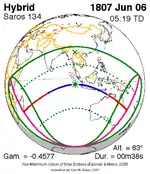 June 6, 1807 |
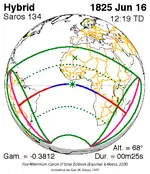 June 16, 1825 |
 June 27, 1843 |
| 35 | 36 | 37 |
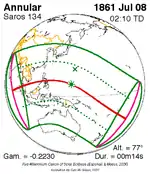 July 8, 1861 |
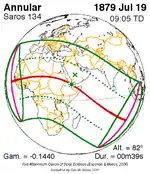 July 19, 1879 |
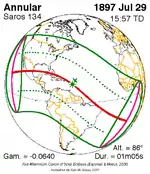 July 29, 1897 |
| 38 | 39 | 40 |
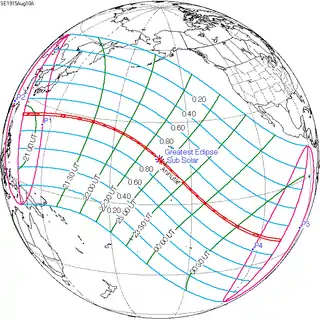 August 10, 1915 |
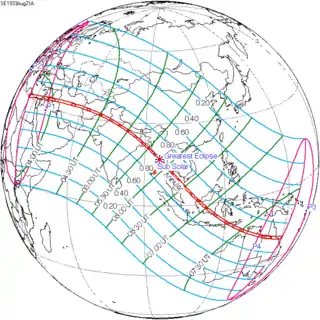 August 21, 1933 |
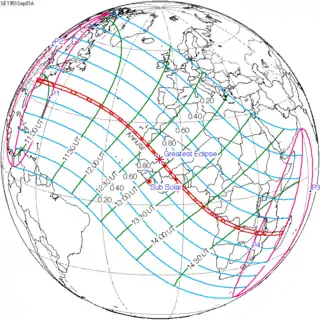 September 1, 1951 |
| 41 | 42 | 43 |
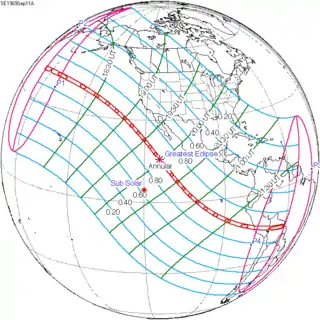 September 11, 1969 |
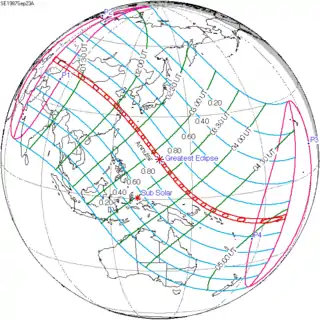 September 23, 1987 |
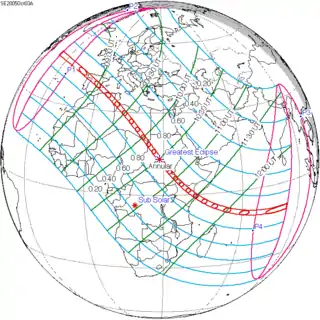 October 3, 2005 |
| 44 | 45 | 46 |
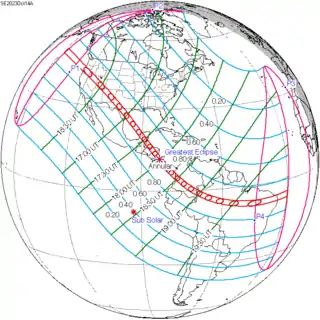 October 14, 2023 |
 October 25, 2041 |
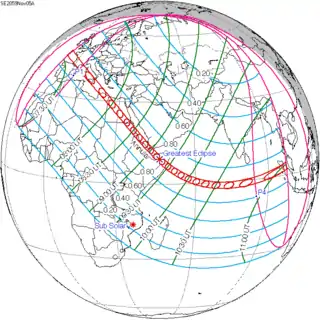 November 5, 2059 |
| 47 | 48 | |
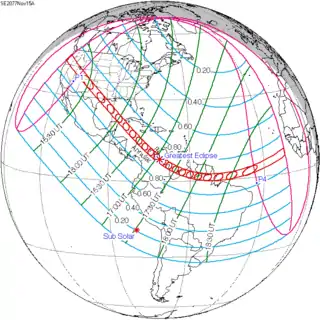 November 15, 2077 |
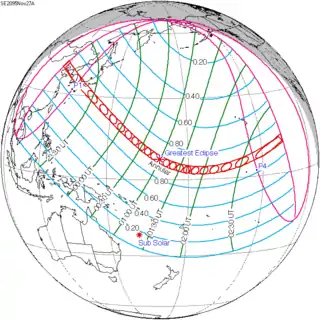 November 27, 2095 | |
Inex Series
This eclipse is a part of the long period inex cycle, repeating at alternating nodes, every 358 synodic months (≈ 10,571.95 days, or 29 years minus 20 days). Their appearance and longitude are irregular due to a lack of synchronization with the anomalistic month (period of perigee). However, groupings of 3 inex cycles (≈ 87 years minus 2 months) comes close (≈ 1,151.02 anomalistic months), so eclipses are similar in these groupings.
| Inex series members between 1901 and 2100: | ||
|---|---|---|
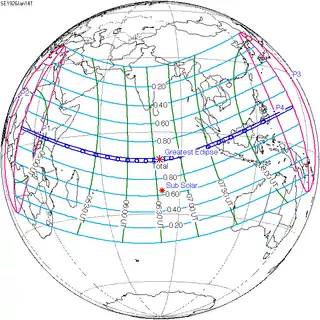 January 14, 1926 (Saros 130) |
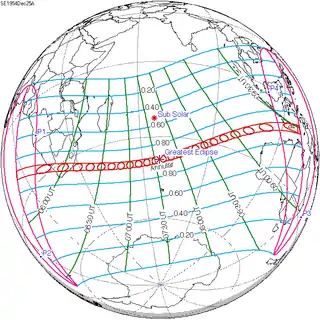 December 25, 1954 (Saros 131) |
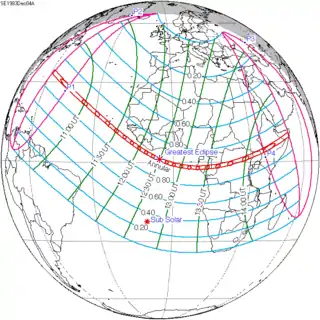 December 4, 1983 (Saros 132) |
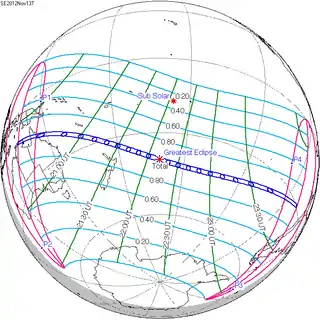 November 13, 2012 (Saros 133) |
 October 25, 2041 (Saros 134) |
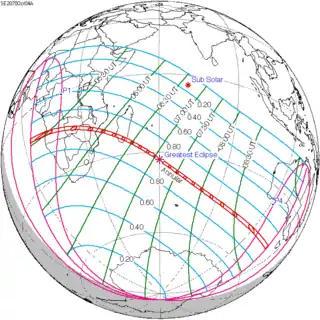 October 4, 2070 (Saros 135) |
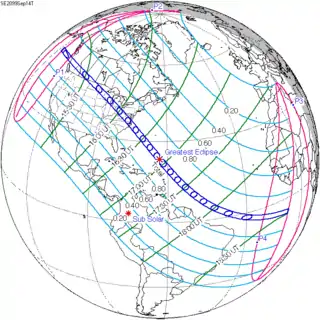 September 14, 2099 (Saros 136) |
||
Metonic cycle
The metonic series repeats eclipses every 19 years (6939.69 days), lasting about 5 cycles. Eclipses occur in nearly the same calendar date. In addition, the octon subseries repeats 1/5 of that or every 3.8 years (1387.94 days). All eclipses in this table occur at the Moon's descending node.
| 21 eclipse events between June 1, 2011 and June 1, 2087 | ||||
|---|---|---|---|---|
| May 31 – June 1 | March 19–20 | January 5–6 | October 24–25 | August 12–13 |
| 118 | 120 | 122 | 124 | 126 |
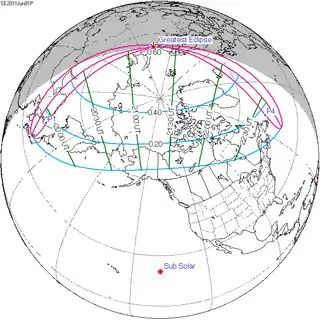 June 1, 2011 |
 March 20, 2015 |
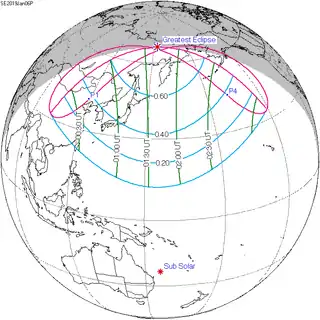 January 6, 2019 |
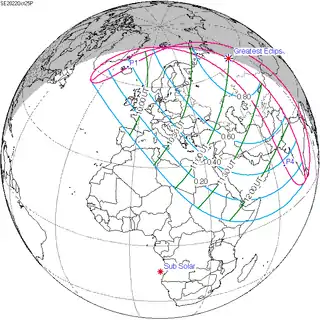 October 25, 2022 |
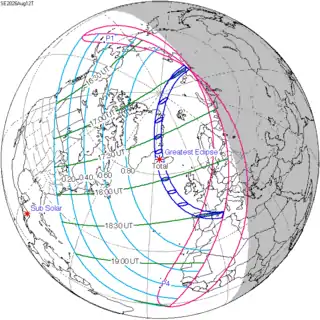 August 12, 2026 |
| 128 | 130 | 132 | 134 | 136 |
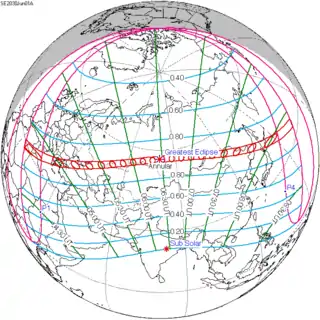 June 1, 2030 |
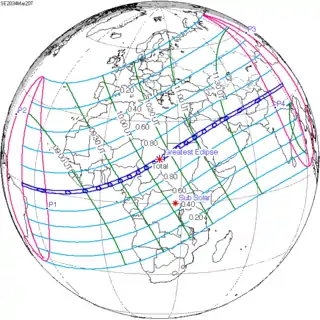 March 20, 2034 |
 January 5, 2038 |
 October 25, 2041 |
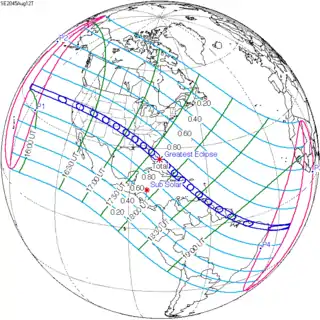 August 12, 2045 |
| 138 | 140 | 142 | 144 | 146 |
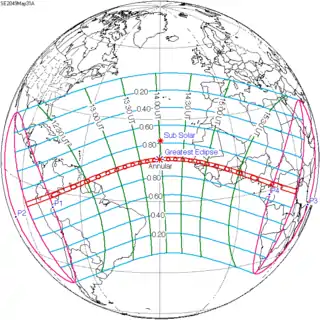 May 31, 2049 |
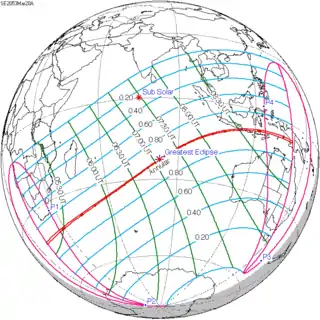 March 20, 2053 |
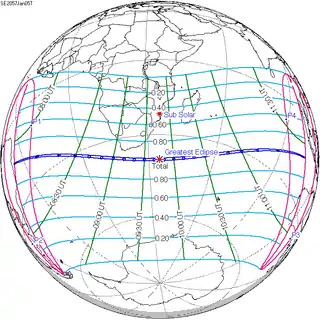 January 5, 2057 |
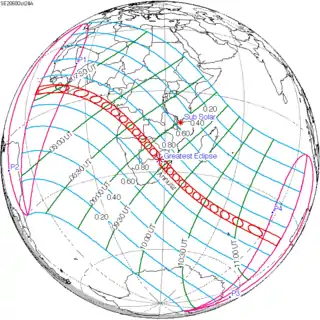 October 24, 2060 |
 August 12, 2064 |
| 148 | 150 | 152 | 154 | 156 |
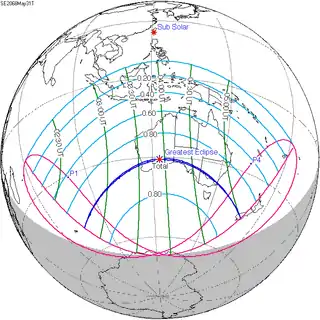 May 31, 2068 |
 March 19, 2072 |
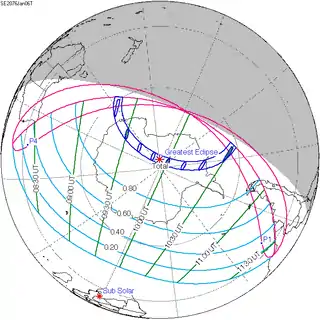 January 6, 2076 |
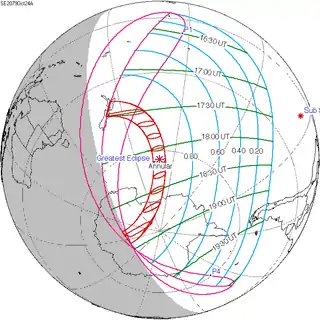 October 24, 2079 |
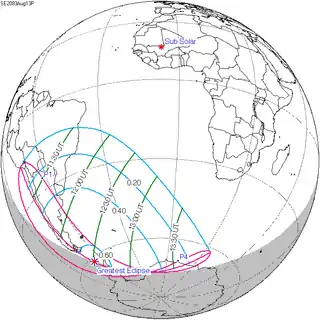 August 13, 2083 |
| 158 | 160 | 162 | 164 | 166 |
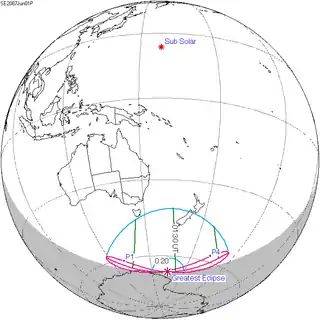 June 1, 2087 |
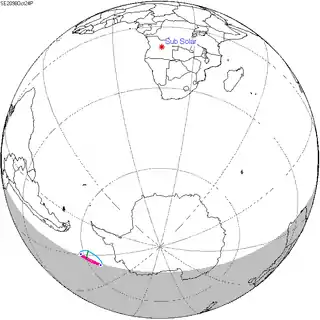 October 24, 2098 |
|||
References
- van Gent, R.H. "Solar- and Lunar-Eclipse Predictions from Antiquity to the Present". A Catalogue of Eclipse Cycles. Utrecht University. Retrieved 6 October 2018.
- http://eclipse.gsfc.nasa.gov/SEsaros/SEsaros134.html
.jpg.webp)

